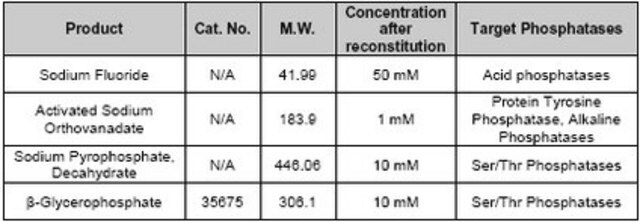PPC1010
Protease and Phosphatase Inhibitor Cocktail
DMSO solution, for the inhibition of serine, cysteine, acid proteases, aminopeptidase, serine/threonine protein phosphatases and L-isozymes of alkaline phosphatase
Sinónimos:
Protease and Phosphatase Inhibitor Mix, Protease and phosphatase inhibitor
About This Item
Productos recomendados
product name
Protease and Phosphatase Inhibitor Cocktail,
form
DMSO solution
Quality Level
packaging
pkg of 1 ml, 5 ml ×
shipped in
wet ice
storage temp.
−20°C
General description
Application
- for cellular protein extraction
- to lyse purified CD4+ T cells
- to prepare protein extracts from placental tissues and cells
Preparation Note
Other Notes
signalword
Warning
hcodes
Hazard Classifications
Eye Irrit. 2 - Skin Irrit. 2
Storage Class
10 - Combustible liquids
wgk_germany
WGK 2
flash_point_f
188.6 °F
flash_point_c
87 °C
Certificados de análisis (COA)
Busque Certificados de análisis (COA) introduciendo el número de lote del producto. Los números de lote se encuentran en la etiqueta del producto después de las palabras «Lot» o «Batch»
¿Ya tiene este producto?
Encuentre la documentación para los productos que ha comprado recientemente en la Biblioteca de documentos.
Los clientes también vieron
Contenido relacionado
Visión general de los métodos de lisis celular y extracción de proteínas: solubilización con detergente, lisis mediante congelación-descongelación, choque osmótico, tratamiento con ultrasonidos, lisis celular enzimática y técnicas de alteración mecánica como la homogeneización con Dounce, Polytron y con mortero y almirez.
An overview of cell lysis and protein extraction methods including detergent solubilization, freeze-thaw lysis, osmotic shock, sonication, enzymatic cell lysis, and mechanical disruption techniques such as Dounce, Polytron, and mortar and pestle homogenization.
Nuestro equipo de científicos tiene experiencia en todas las áreas de investigación: Ciencias de la vida, Ciencia de los materiales, Síntesis química, Cromatografía, Analítica y muchas otras.
Póngase en contacto con el Servicio técnico

















